Restoration of immunity with the help of the device Spinor
The immune system plays an enormous role in the regeneration of cells.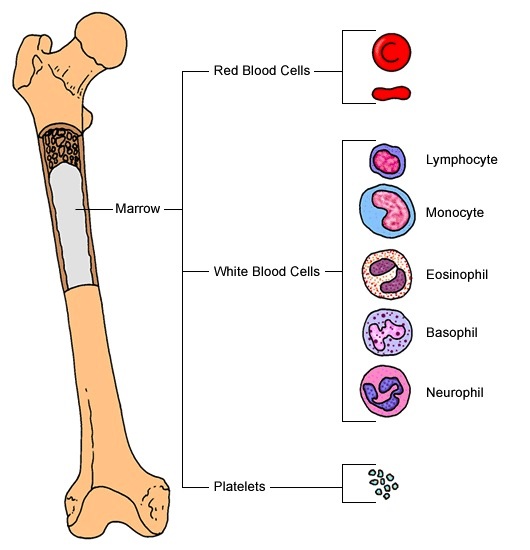 The bone marrow contains one of the most important roles. The immune system withdraws all the information from the blood, and the cells of any organ and system. These are called stem cells. Bone marrow is located in the sternum, the tubular bones of hands and feet, pelvic bones, and the vertebrae.
The bone marrow contains one of the most important roles. The immune system withdraws all the information from the blood, and the cells of any organ and system. These are called stem cells. Bone marrow is located in the sternum, the tubular bones of hands and feet, pelvic bones, and the vertebrae.
The Organs of the Immune System
Bone Marrow — All the cells of the immune system are initially derived from the bone marrow.
They form through a process called hematopoiesis. During hematopoiesis, derived stem cells differentiate into either mature cells of the immune system, or into precursors of cells that migrate out of the bone marrow, to continue their maturation elsewhere. The bone marrow produces B cells, natural killer cells, granulocytes and immature thymocytes, in addition to red blood cells and platelets.
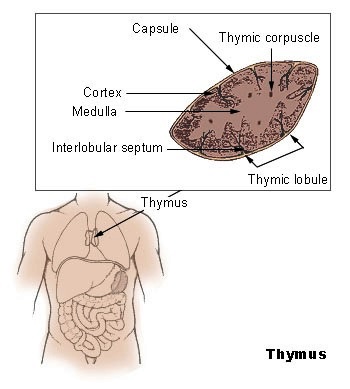 Thymus — The function of the thymus is to produce mature T-cells.
Thymus — The function of the thymus is to produce mature T-cells.
Immature thymocytes, also known as prothymocytes, leave the bone marrow, and migrate into the thymus. Through a remarkable maturation process sometimes referred to as thymic education, T-cells that are beneficial to the immune system are spared, while those T-cells that might evoke a detrimental autoimmune response are eliminated. The mature and beneficial T-cells are then released into the bloodstream.
Spleen — The spleen is an immunologic filter of the blood.
It is made up of B-cells, T-cells, 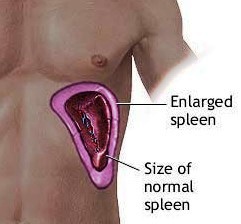 macrophages, dendritic cells, natural killer cells and red blood cells. In addition to capturing foreign materials (antigens) from the blood, that passes through the spleen, migratory macrophages and dendritic cells, bring antigens to the spleen via the bloodstream. An immune response is initiated when the macrophage or dendritic cells present the antigen to the appropriate B-Cell or T-cells. This organ can be thought of as an immunological conference center. In the spleen, B-cells become activated and produce large amounts of antibody. In addition, old red blood cells become destroyed in the spleen.
macrophages, dendritic cells, natural killer cells and red blood cells. In addition to capturing foreign materials (antigens) from the blood, that passes through the spleen, migratory macrophages and dendritic cells, bring antigens to the spleen via the bloodstream. An immune response is initiated when the macrophage or dendritic cells present the antigen to the appropriate B-Cell or T-cells. This organ can be thought of as an immunological conference center. In the spleen, B-cells become activated and produce large amounts of antibody. In addition, old red blood cells become destroyed in the spleen.
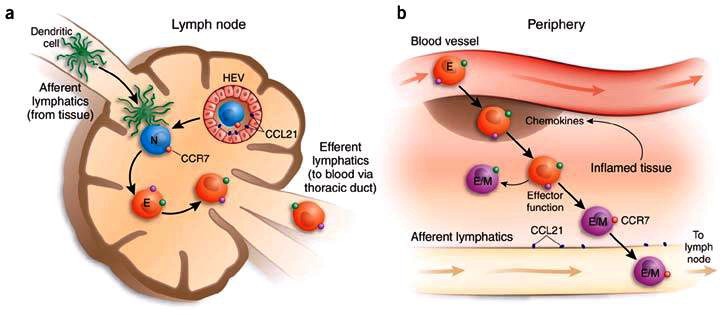 Lymph Nodes — The lymph nodes function as an immunologic filter for the bodily fluid known as lymph.
Lymph Nodes — The lymph nodes function as an immunologic filter for the bodily fluid known as lymph.
Lymph nodes are found throughout the body, and are composed mainly of T-cells, B-cells, dendritic cells and macrophages. The lymph nodes drain fluid from most of our tissues. Antigens are filtered out of the lymph, in the lymph node, before returning the lymph to the bloodstream. In a similar fashion as the spleen, the macrophages and dendritic cells that capture antigens present these foreign materials to T-Cells and B-cells, consequently initiating an immune response.
What the Immune System Does
The immune system is the body’s defense mechanism against infectious organisms and other invaders. Through a series of steps called the immune response, the immune system attacks organisms and substances that invade the human body and causes disease. The immune system is made up of a network of cells, tissues, and organs that work together to protect the human body.
The cells that are part of this defense mechanism, are white blood cells, or leukocytes. They come in two basic types, which combine to seek out and destroy the organisms or substances that causes disease:
- Phagocytes are cells that feed on invading organisms
- Lymphocytes are cells which allow the human body to remember and recognize previous invaders, and to assist the human body in destroying them.
There are two kinds of lymphocytes: the B-lymphocytes and the T-lymphocytes. Lymphocytes initiate from the bone marrow, and either remain there and mature into B-cells, or they disperse towards the thymus gland, where they mature into T-cells. B-lymphocytes and T-lymphocytes have separate jobs to do: B-lymphocytes are like the body’s military intelligence system, seeking out their targets and sending defenses to hold onto them. T-lymphocytes are like the soldiers, destroying the invaders that the intelligence system has identified. Here’s how it works:
Antigens are foreign substances that invade the human body. When an antigen is detected, several types of cells work together to recognize and respond to it. These cells trigger the B-lymphocytes to produce antibodies, specialized proteins, which hold onto specific antigens. Antibodies and antigens fit together perfectly like a key and a lock.
Once the B-lymphocytes have produced antibodies, these antibodies continue to exist in the human body, so that if the same antigen is presented to the immune system again, the antibodies are already there to do their job. That’s why if someone gets sick with a certain disease, like chickenpox, that person typically doesn’t get sick from it again. This is also why we use immunizations to prevent getting certain diseases. The immunization introduces the body to the antigen in a way that doesn’t make a person sick, but it does allow the body to produce antibodies that will then protect that person from future attack, by the germ or substance, which produces that particular disease.
Although antibodies can recognize an antigen and hold onto it, they are not capable of destroying it without help. That is the job of the T-cells. The T-cells are part of the system that destroys antigens that have been tagged by antibodies or cells, which have been infected or somehow altered. (There are actually T-cells that are described as «killer cells.») T-cells are also involved in helping signal other cells (like phagocytes) to complete their tasks.
Antibodies can also neutralize toxins, (poisonous or damaging substances), produced by different organisms. And lastly, antibodies can activate a group of proteins called complement , which are also part of the immune system. Complement assists in killing bacteria, viruses, or infected cells.
All of these specialized cells and parts of the immune system offer the human body protection against disease. This protection is called immunity.
Humans have three types of immunity:
- innate,
- adaptive,
- passive.
Innate Immunity
Everyone is born with innate (or natural) immunity, a type of general protection that humans possess. Many of the germs that affect other species don’t harm us. For example, the viruses that cause leukemia in cats or distemper in dogs does not affect humans. Innate immunity works both ways because some viruses that make humans ill — such as the virus that causes HIV/AIDS — does not, for example, affect cats or dog.
Innate immunity also includes the external barriers of the human body, for example the skin and mucous membranes (the internal lining of the nose, throat, and gastrointestinal tract), which are our first line of defense in preventing diseases from entering the human body. If this outer defensive wall is broken (for example if you receive a cut), the skin attempts to heal the break quickly, and special immune cells on the skin surface, attack invading germs.
Adaptive Immunity
We also have a second kind of protection called adaptive (or active) immunity. This type of immunity develops throughout the entire human lifespan. Adaptive immunity involves the lymphocytes, which are for example exposed to diseases, or immunized against diseases via vaccination.
Passive Immunity
Passive immunity is «borrowed» from another source, and it lasts for a brief time. For example, antibodies from breast milk of a mother, provides its infant, with temporary immunity to diseases that the mother has been exposed to. This can help protect the infant against infection, during the early years of childhood.
Every individual’s immune system is different. Some humans never seem to get infections, whereas others seem to be sick all the time. As humans get older, they usually become more immune to germs, as the immune system increases contact and exposure to them. That’s why adults and teenagers tend to get fewer colds than young children, due to the fact their bodies have learned to recognize, adapt, and immediately attack many of the viruses which cause colds.
Things That May Go Wrong With the Immune System
Disorders of the immune system are broken down into four major categories:
- Immunodeficiency disorders (primary or acquired).
- Autoimmune disorders (The human body’s own immune system, attacks its own tissue as foreign matter).
- Allergic disorders (The human body’s own immune system, overreacts in response to an antigen).
- Cancers of the human body’s immune system.
Autoimmune Disorders
In autoimmune disorders, the human body’s own immune system mistakenly attacks the body’s healthy organs and tissues as though they were foreign invaders. Autoimmune diseases include:
- Lupus is a chronic disease marked by muscle, joint pain, and inflammation. The abnormal immune response may also involve attacks on the kidneys and other organs.
- Juvenile rheumatoid arthritis, is a disease in which the human body’s own immune system acts as though certain body parts, such as the joints of the knee, hand, and foot, are foreign tissue, and attacks them.
- Scleroderma is a chronic autoimmune disease that can lead to inflammation, and cause damage of the skin, joints, and other internal organs.
- Ankylosing spondylitis is a disease that involves inflammation of the spine and joints, causing stiffness and severe pain.
- Dermatomyositis is a disorder marked by inflammation and damage to the skin area as well as the muscles.
Allergic Disorders
Allergic disorders occur when the human body’s own immune system overreacts to exposure to antigens, contained in the environment. The substances which provoke such attacks are called allergens. The immune response can cause symptoms such as swelling, watery eyes, and sneezing, and even possibly a life-threatening reaction called anaphylaxis. Taking medications called antihistamines can relieve most symptoms, but will not remedy the problem. Allergic disorders include:
- Asthma, a respiratory disorder that can cause breathing problems, which frequently involves an allergic response from the lungs. If the lungs are oversensitive to certain allergens (like pollen, molds, animal dander, or dust mites), it may trigger breathing tubes in the lungs to become narrowed, leading to reduced airflow and making it difficult for a person to breathe.
- Eczema is an itchy rash also known as atopic dermatitis. Although atopic dermatitis is not necessarily caused by an allergic reaction, it more often than not occurs in children and teenagers who have allergies, hay fever, or asthma, or who have a family history of these conditions.
- Allergies of several types can occur in children and teenagers, such as environmental allergies (for example to dust mites), seasonal allergies (such as hay fever), drug allergies (reactions to specific medications), food allergies (such as to nuts), and allergies to toxins (for example bee stings).
- We have now established that one of the primary components of the human body’s immune system, is the thymus gland. This is the area where the T-lymphocyte matures.
- Plots of lymphoid tissue are in the intestines, lungs, spleen and liver.
Restoration of immune system by device SPINOR
Method of using Cem-Tech — Divided into two sections:
- Overall – Used in order to restore the human body’s immune system
- Used against specific infections
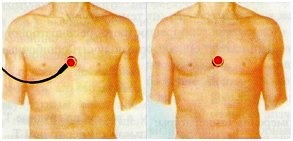
1. Overall program:
a) In the 1st Mode, apply the red or yellow emitter, as shown in the pictures, by the sternum (bone marrow).
When it stops, detach the crystal tablet from the wire, and place it with tape on the same
spot that you took the information from. (For approximately 12-24 hours)
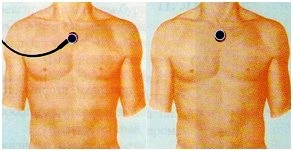
Duration: 5 — 7 days.
b) In the 1st Mode apply the blue or yellow emitter, as shown on the pictures, by the thymus gland. When it stops, detach the tablet from the wire, and place it with tape on the same spot that you took the information from. (For approximately 12-24 hours)
Duration: 5 — 7 days.
c) In the 1st Mode apply the red or yellow emitter by the blood vessel (radial artery). When it stops, detach the tablet from the wire, and place it with tape on the same spot that you took the information from. (For approximately 8 — 12 hours)
Duration: 5 — 7 days.
d) In the 1st Mode, apply the red or yellow emitter, as shown in the pictures below, by the sternum (bone marrow).
When it stops, detach the tablet from the wire, and place it with tape on blood vessel (radial artery) For approximately 8 — 12 hours.
Duration: 3 — 7 days.
2. Removal of a specific infection from the body.
a) In the 1st Mode (or another mode in accordance with the disease), apply the yellow emitterat at problem zone (for example, over the projection of the nasopharynx). When it stops, detach the tablet from the wire, and place it with tape on radial artery for approximately 8 — 12 hours.
b)In the 2nd Mode apply other yellow emitterat to the same area (for example, over the projection of the nasopharynx).
When it stops, detach the tablet from the wire, and place it with tape on the same spot that you took the information from for approximately 8 — 12 hours.
Duration: 5 — 7 days.
The device and the procedure’s that where stated in this article give an opportunity to restrict the usage of drugs, and greatly aids and facilitate the patient’s condition.